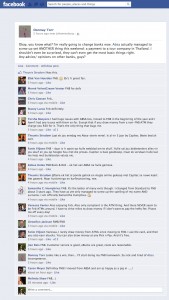A little over a year ago, our CEO Kim Browne and our MD Louis Eksteen sat down and penned an article on their predictions for 2012. I’ll be doing the same as well, but I thought it’d be fun to look back at their predictions and rate how well they did.
Prediction 1: Advertising as conversation
Short-form cost-efficient advertising, driven by micro media such as Twitter and Facebook, will become more prevalent, while long-form expensive commercials fade a bit. Advertising as conversation is the result.
Rating: 8/10. This is mostly true. 2012 has seen the wholescale uptake of social media. You could get away with not having a social media presence in 2011 as a brand, but in 2012 you’d be out in the cold. These brands are increasingly leveraging the power of their (by now) well-developed social media platforms to engage with their userbase. In my own personal experience, I’ve seen conversations on social media platforms that are more powerful endorsements and sales tools for brands than any advertisement. Here’s a conversation on Facebook among some of my connections that happened this week:
You don’t get more conclusive proof of the power of social media.
Prediction 2: iPad 3 is launched
Why list a product launch prediction? Because the iPad 3 will respond to increasing pressure from successful “other” tablets such as the Android-driven Samsung Galaxy Tab, by offering easier, faster and cheaper access to the new media world. Significantly more people will connect via iPad, making it an important advertising medium in its own right.
Rating: 7/10. This was an easy one to call. I would have awarded serious bonus points for predicting the iPad Mini.
Prediction 3: Media apps want to be free
Newspapers have seemingly given up on trying to charge for their content. While paper versions still charge via a cover price, the same newspapers’ apps are free, predominantly on iPad/iPhone. As far as business models go free is, well … free.
Rating: 5/10. A mixed bag. Online, while most media have dismantled their ill-conceived pay walls or kept their content free, there’s been a few notable holdouts. FT.com, NYtimes.com and bizarrely, TheOnion.com have all implemented and kept their content paygating, with a selection of free articles and paid services to access all content.
On devices, the launch of Apple Newstand late last year changed the playing field completely. Before Newstand, media owners had to develop individual apps to distribute their content, with billing often haphazard or not properly implemented. Newstand allowed publishers to consolidate their offerings and those that did have bought into the paid content ecosystem. Some publishers such as Business Day have opted to maintain their own apps and deliver their content for free.
Prediction 4: Bundle or die
The bundling of products across the board by media companies will drive new media business models. This means the purchase of different products on a variety of platforms will go some way in rescuing income streams. Think pay television bouquets. Media companies will offer many products (newspapers, magazines, video) to pick and choose from via bundle offers that include less or more depending on bouquet bought. It’s the only way left for media companies to charge for digitally delivered content products. Buy one, get a lot free.
Rating: 10/10. Spot on. Locally this has been absolutely the case with magazines bundling multiple titles together, both digitally and print.
Prediction 5: Advertising agencies notice content
As brand content is increasingly the driver of advertising as conversation, agencies will start offering real content services, delivered by experienced media creators, rather than traditional advertising types.
Rating: 10/10. No need to look any further than Felix Baumgartner’s space jump for Red Bull, the Chevy Sonic video by OK Go or a multitude of other innovative brand content executions for proof.
Prediction 6: Chief content officers
Brand owners will start appointing senior, content media-savvy executives in powerful marketing roles to ensure quality brand content creation and delivery. The title of chief content officer (CCO) will be used.
Rating: 8/10. While this has certainly been the case abroad, locally the concept is still gaining traction. 2012 may have been the year where the term ‘chief content officer’ become widespread, but it’s going to take at least another year before locally we see locally companies catching on. Positively, 2012 saw the launch of the Content Marketing Institute’s Chief Content Officer magazine.
Prediction 7: Presentation art
PowerPoint will fade. The idea of everyone making the same slides from the same boring bullet point templates will give way to visually-driven presentation art. Imagery that conveys ideas while the presenter does the talking will attract more attention than slides-by-numbers.
Rating: 1/10. A case of unfettered idealism perhaps, but PowerPoint remains dominant, and boring bullet point templates are still very much de rigeur. On the plus side, Prezi continues to grow in popularity with more and more large corporates coming over to the value of presentation art.
Prediction 8: The end of the QR code
Few consumers use quick response codes as it’s often easier to type a URL than to shoot a barcode with your phone. While these nifty-looking gadgety things remain popular with agencies, in reality they don’t really deliver responses. Remember those irritating Bluetooth messages as you enter shopping malls? QR codes are going the same way.
Rating: 2/10. Again, wishful thinking here, but I can hardly blame them. QR codes are ridiculous things that serve very little purpose and deliver no real value. QR codes should be heading out the door, but they’re still hugely popular. Media24 magazines have just recently decided to implement a QR code system, and the little black and white squares are practically ubiquitous on product packaging.
Prediction 9: Google+ will not deliver like Facebook does
It’s popular amongst the digerati to talk up Google+. Perhaps it’s because, for these people, Facebook has become passé. But in realty Google+ is simply another Facebook wannabe. And with Timeline Facebook has moved the goalposts well north of Google+. Driven by its initial public offering and a huge increase in advertising income (in part due to the nifty Timeline-like layout and other subtle redesigns), Facebook will become stronger, while Google+ will sort-of be around.
Rating: 8/10. A good call that’s proved to be spot on. Google+ has languished in a sort of no-mans-land for much of the year, although it is starting to gain traction. Google Hangouts in particular are proving to be an exciting opportunity for brands to connect with fans and with Google+’s value in terms of SEO, brands are creating their presences, even if the general feeling is that this is more perfunctory rather than truly exciting.
Prediction 10: The art of writing
In a content driven marketing world creative writers, not copy writers, will document a brand’s story myth via digital means. Brand chief content officers will enlist the help of creative writers to produce and polish quality written marketing material to which consumers will respond in an engaged way.
Rating: 7/10. Again, perhaps a slight case of wishful thinking but the reality is that for the most part, copy writers are still in charge of producing the communications with which a brand engages with its fans. Coca Cola’s oft-discussed Content 2020 strategy is however blazing the trail for other brands to follow.
Prediction 11: Brands are publishers
In a world in which all brands have become content brands, owners will increasingly have to act as if they are content creators themselves. It will become important for brands to act like media when communicating with consumers, while they stay true to their own essence at the same time.
Rating: 9/10. You need only look for your favourite brand on Facebook and Twitter to see the proof of this. While the quality of the content varies widely, brands have firmly embraced their new roles as publishers. The brands that haven’t have suffered widely as a result.
Rating: 9/10. You need only look for your favourite brand on Facebook and Twitter to see the proof of this. While the quality of the content varies widely, brands have firmly embraced their new roles as publishers. The brands that haven’t have suffered widely as a result.
Prediction 12: Seamless integration of media creation tools
One of the reasons why brands are publishers and consumers are in control of the marketing message, is the free and easy access everyone now has to professional media creation tools. What was once the preserve of only huge media corporations, are now available to everyone. The use of clever apps such as Instagram and others automates great-looking visual material that everyone can do. These tools will be integrated in everyone’s digital environment to allow for pro-media creation on the fly. Marketers have been slow to react, but next year will see tool integration as part of communication plans.
Rating: 7/10. A mixed bad. Media creation tools such as Paper, Instagram, Prezi and a host of photo and video creation apps too numerous to name have certainly provided ample opportunity for the creation of professional-level media creation on fly. The reality is that professional media creation typically requires professional media training. What’s really great is that the availability of these tools on mobile devices has allowed for the creation of pro media on the go, creating exciting new possibilities for brand content creation in real time.
Overall rating: 8/10
On the whole, Kim and Louis did a really good job at predicting the top trends for 2012. There was a case of some wishful thinking, but I can hardly blame them. Can anyone honestly say that they wouldn’t want to see fewer PowerPoints or QR codes? I’d love to hope that 2013 is the year that both QR codes and PowerPoint are finally retired, but the reality is we’ll probably have the around for quite some time still.





